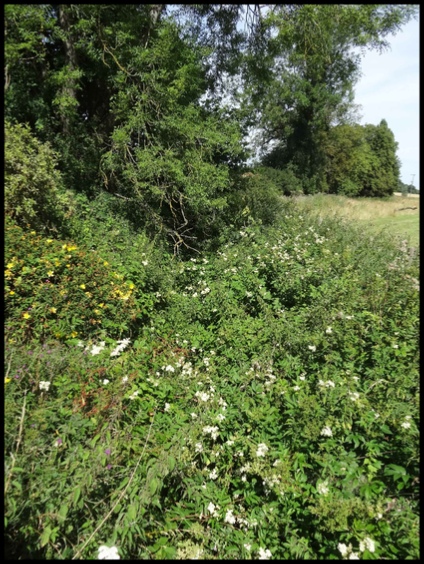
UP THE RODING
An occasional blog about walking in the edgelands of North East London and various other places
There is no comments capability on this blog, but you can send me an email at blog@holli.co.uk
WALKING THE RIVER RODING FROM THAMES TO SOURCE
Leg 7: Through Fyfield
21 August 2016
Returning to Chipping Ongar, I took the path that leads out of the car park and followed it downhill towards the Roding. This is a well-
Looking back uphill, across the field of crops, a dead tree was silhouetted against the grey skies

WALKING THE RIVER RODING FROM THAMES TO SOURCE
Leg 6: Upstream to Ongar
6 August 2016
I was at last able to return to Passingford Bridge, where the River Roding flows under the A113 on its way towards the suburbs of east London. This leg of my walk would take me upstream to the small market town of Chipping Ongar -

Fifty yards away was a narrow road, Albyns Lane, which I followed for about half-
THE LAND ART OF THEYDON BOIS
27 July 2016
Travelling out of London along the M11 motorway, you will probably notice a field containing a set of concentric earth banks. This structure appeared a few years ago, and I’ve often wondered what on earth it could be … An emergency services helipad? A target area of some sort? Something to do with Essex Water? I recently discovered that it is in fact a land art installation by the sculptor, Richard Harris. So I decided to take a close-
I took the Central Line eastwards, along the section which runs above-

WHAT IS IT WITH ALL THIS WALKING AND WRITING?
16 August 2015
Something different, between walks, featuring a video clip of Iain Sinclair, Michael Moorcock and Alan Moore …
Iain Sinclair is well-
In fact, I only really understood what joined Sinclair and Ballard when I attended a three-
ACROSS TO TWO TREE ISLAND
30 August 2016
A walk along a stretch of the Thames Estuary -
One of my favourite Essex walks is along the sea wall which runs beside Benfleet Creek on the North side of the River Thames, and then over to Two Tree Island. It is usually hot when I visit Benfleet and today was going to be no exception, so I made sure that I arrived at the start of the walk in Hadleigh country park before ten o’clock. The country park now includes the adjacent farm land that was used for the 2012 Olympic Mountain Biking events, and has re-
Avoiding the scores of mountain bikers who were also intent on an early start, I walked downhill through the trees. These soon opened up to give views over Canvey Island, famed for the floods that killed 58 people in 1953 and for the music of Dr. Feelgood. The most prominent sight was that of the oil silos and crane gantries at the nearby Coryton Refinery -

Looking down over Benfleet Creek and Canvey Island, towards the oil silos and crane gantries at Coryton
WALKING THE RIVER RODING FROM THAMES TO SOURCE
Leg 8: The Roding Villages
21 November 2016
This leg of my walk took me past the Rodings, the nine villages or hamlets that bear the name of the river: Abbess Roding, Aythorpe Roding, Beauchamp Roding, Berners Roding, High Roding, Leaden Roding, Margaret Roding, Morell Roding, and White Roding. Although it meanders between them, the river does not actually pass through any of the villages -
Upstream from Shellow Bridge, where I ended the previous leg of my walk, the river passes through Birds Green Fishery. It was a rather cool and cloudy day, but there were still a few enthusiasts huddled underneath their umbrellas and tents by the side of the lakes.

One of the Birds Green fishing lakes
WALKING THE RIVER RODING FROM THAMES TO SOURCE
Leg 9: To the Source …
20 July 2017
I started the final leg of my walk up the River Roding from the church at Great Canfield. The Roding runs by the side of the road that passes through the village, but was covered by a thick mass of vegetation that made it impossible to tell if there was any water running underneath. I was rather concerned that the upper stretch of the river would have dried out in the hot July weather; however, half a mile further on, near a footbridge crossing, I found that its waters were still flowing.

The River Roding at Great Canfield. But is there any water under all that foliage?